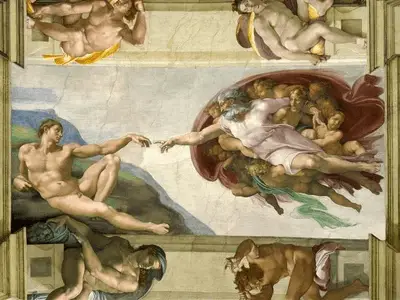Title of Artwork: “Sistine Chapel Ceiling: Creation of Adam”

Artwork by Michelangelo
Year Created 1510
Summary of Sistine Chapel Ceiling: Creation of Adam
Finished between 1508 and 1512, Michelangelo’s fresco work The Creation of Adam (Italian: Creazione di Adamo) is a section of the ceiling in the Sistine Chapel.
From the Book of Genesis, it depicts God creating the first man, Adam, and breathing life into him. The fresco is the fourth in a sequence of panels showing events from Genesis and is part of a larger, more intricate iconographic plan.
There is no more universally recognised symbol of mankind than the image of God and Adam’s hands nearly touching. Numerous copies and parodies of the picture exist. The Creation of Adam by Michelangelo has been copied more than any other religious painting.
All About Sistine Chapel Ceiling: Creation of Adam
Michelangelo was beckoned back to Rome in 1505 by the newly installed Pope Julius II. With a deadline of five years, he was tasked with constructing a tomb for the Pope that would have forty statues.
Michelangelo’s work on the tomb was frequently diverted away from it under the Pope’s patronage so that he might complete a wide variety of other projects.
Although Michelangelo spent forty years on the tomb, he was never satisfied with the final product. It was finished in 1516 and is housed at the Church of S. Pietro in Vincoli in Rome. Its primary figure, Moses, has become his most well-known work.
The Rebellious Slave and the Dying Slave, two more statues commissioned for the tomb, are currently on display in the Louvre.
Michelangelo spent almost four years during this time period painting the Sistine Chapel’s ceiling (1508–1512). Condivi claims that when working on St. Peter’s Basilica, Bramante hated Michelangelo’s commission for the Pope’s tomb and got the Pope to commission him in a medium with which he was inexperienced so that Michelangelo would fail at the task.
Michelangelo was originally hired to decorate the middle part of the ceiling and paint the Twelve Apostles on the triangular pendentives that held it up.
Michelangelo convinced Pope Julius to let him do anything he wanted, and he came up with a far more intricate plan that would depict the Creation, the Fall of Man, the Promise of Salvation through the prophets, and the Genealogy of Christ.
The piece is integrated into a broader decorative design in the chapel that allegorically symbolises the teachings of the Catholic Church.
There are more than 300 figures in the mural, which covers more than 500 square metres of ceiling space. Nine stories from the Book of Genesis serve as its backbone.
These stories are broken up into three categories: God’s creation of Earth, God’s creation of humanity and their fall from grace, and finally, the state of humanity as represented by Noah and his family.
There are twelve foretellers of Jesus’ arrival depicted on the pendentives holding up the ceiling. Seven of them were Israelite prophets, while the other five were Sibyls, women of the Classical culture who also had visions.
Images of Adam and Eve in the Garden of Eden, the Deluge, the Prophet Jeremiah, and the Cumaean Sibyl are only some of the most well-known paintings on the ceiling.
Information Citations:
En.wikipedia.org, https://en.wikipedia.org/.
























